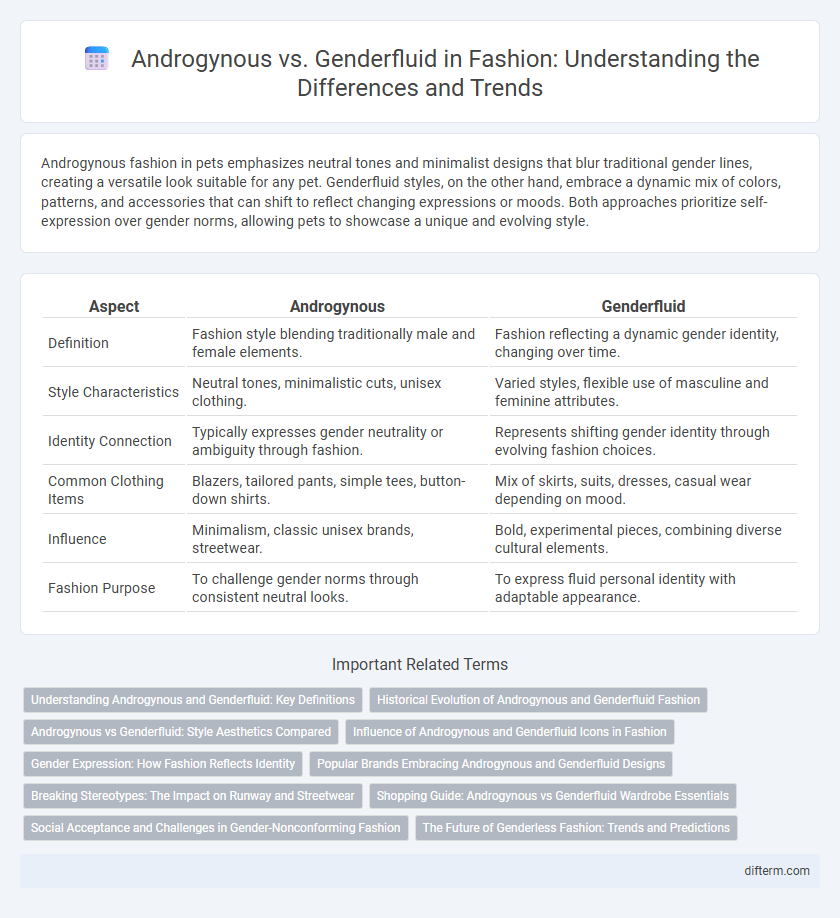Androgynous fashion in pets emphasizes neutral tones and minimalist designs that blur traditional gender lines, creating a versatile look suitable for any pet. Genderfluid styles, on the other hand, embrace a dynamic mix of colors, patterns, and accessories that can shift to reflect changing expressions or moods. Both approaches prioritize self-expression over gender norms, allowing pets to showcase a unique and evolving style.
Table of Comparison
| Aspect | Androgynous | Genderfluid |
|---|---|---|
| Definition | Fashion style blending traditionally male and female elements. | Fashion reflecting a dynamic gender identity, changing over time. |
| Style Characteristics | Neutral tones, minimalistic cuts, unisex clothing. | Varied styles, flexible use of masculine and feminine attributes. |
| Identity Connection | Typically expresses gender neutrality or ambiguity through fashion. | Represents shifting gender identity through evolving fashion choices. |
| Common Clothing Items | Blazers, tailored pants, simple tees, button-down shirts. | Mix of skirts, suits, dresses, casual wear depending on mood. |
| Influence | Minimalism, classic unisex brands, streetwear. | Bold, experimental pieces, combining diverse cultural elements. |
| Fashion Purpose | To challenge gender norms through consistent neutral looks. | To express fluid personal identity with adaptable appearance. |
Understanding Androgynous and Genderfluid: Key Definitions
Androgynous fashion blends traditionally masculine and feminine elements, emphasizing neutral styles that challenge binary gender norms. Genderfluid expression shifts between different gender identities over time, resulting in a dynamic wardrobe that reflects evolving personal identity. Understanding these concepts highlights the importance of inclusivity and self-expression within contemporary fashion trends.
Historical Evolution of Androgynous and Genderfluid Fashion
Androgynous fashion, rooted in early 20th-century movements such as the flapper era and Marlene Dietrich's iconic style, challenges traditional gender norms by blending masculine and feminine elements into a cohesive look. Genderfluid fashion has evolved more recently, gaining visibility through LGBTQ+ activism and social media platforms that celebrate non-binary expression and fluid identities. Both styles reflect broader cultural shifts toward inclusivity, with designers like Jean-Paul Gaultier and Telfar Clemens pushing boundaries by creating garments that transcend fixed gender categories.
Androgynous vs Genderfluid: Style Aesthetics Compared
Androgynous style emphasizes a blend of traditionally masculine and feminine elements, often featuring neutral tones, tailored cuts, and minimalistic designs that blur gender distinctions. Genderfluid fashion embraces versatility and changeability, incorporating a mix of bold colors, varied silhouettes, and eclectic accessories that shift depending on the wearer's mood or identity expression. Both aesthetics challenge conventional gender norms but differ in their approach: androgynous aims for constant gender ambiguity, while genderfluid celebrates dynamic fluctuation in presentation.
Influence of Androgynous and Genderfluid Icons in Fashion
Androgynous and genderfluid icons have significantly reshaped fashion by challenging traditional gender norms and inspiring designers to create more inclusive collections. Figures such as Tilda Swinton and Jaden Smith blur conventional boundaries, promoting styles that blend masculine and feminine elements seamlessly. Their influence drives a broader acceptance of adaptive fashion, encouraging self-expression beyond binary definitions.
Gender Expression: How Fashion Reflects Identity
Androgynous fashion embraces blending traditionally male and female clothing elements to create a unified, gender-neutral aesthetic, reflecting a stable and consistent gender expression. Genderfluid fashion shifts dynamically, incorporating a wide range of styles that fluctuate with the wearer's gender identity, showcasing a fluid and evolving self-representation. Both styles highlight how fashion serves as a powerful medium for articulating personal identity beyond binary norms.
Popular Brands Embracing Androgynous and Genderfluid Designs
Popular brands such as Gucci, Telfar, and Rad Hourani lead the fashion industry with androgynous collections that blur traditional gender lines through unisex tailoring and neutral palettes. Genderfluid fashion gains momentum with designers like Harris Reed and Collina Strada, who incorporate versatile, adaptable pieces that celebrate identity fluidity. These brands emphasize inclusivity and self-expression, challenging conventional norms by promoting diverse styles that resonate across gender spectra.
Breaking Stereotypes: The Impact on Runway and Streetwear
Androgynous and genderfluid fashion challenge traditional gender norms by blending masculine and feminine elements, fostering inclusivity on runways and in streetwear culture. Designers embrace fluid silhouettes and versatile pieces that defy binary categorization, reflecting a broader societal shift toward self-expression beyond fixed identities. This evolution significantly influences fashion trends, encouraging diverse representation and breaking down barriers within the industry.
Shopping Guide: Androgynous vs Genderfluid Wardrobe Essentials
Androgynous wardrobes emphasize neutral tones, minimalist cuts, and versatile pieces like tailored blazers, classic white shirts, and straight-leg jeans that blur traditional gender lines. Genderfluid fashion embraces a dynamic mix of styles, combining elements such as bold accessories, layered clothing, and a spectrum of colors to reflect changing gender expressions. Key shopping essentials include mix-and-match staples that support fluid self-expression while maintaining comfort and style flexibility.
Social Acceptance and Challenges in Gender-Nonconforming Fashion
Social acceptance of androgynous fashion often centers around blending traditionally masculine and feminine elements, making it more recognizable and accessible in mainstream culture. Genderfluid fashion faces unique challenges due to its emphasis on constant change, which can defy societal expectations and limit market availability. Both expressions challenge rigid gender norms but encounter differing degrees of acceptance based on cultural and social contexts.
The Future of Genderless Fashion: Trends and Predictions
The future of genderless fashion is shaped by the blending of androgynous and genderfluid styles, emphasizing versatility and self-expression beyond traditional gender norms. Androgynous fashion features neutral silhouettes and minimalistic designs, while genderfluid fashion embraces dynamic changes that reflect an individual's evolving identity. Emerging trends include adaptable clothing with inclusive sizing and sustainable materials, signaling a shift towards a more diverse and flexible fashion landscape.
androgynous vs genderfluid Infographic

 difterm.com
difterm.com